This page highlights Images from Holy Week that appear on the Irish High Crosses.
Introduction
The events of Holy Week, the last week of Jesus' life, are central to the Christian message. The makers of the Irish High Crosses included some of these events while completely ignoring others. Featured here are images from eight events that took place between Palm Sunday and Good Friday before the Crucifixion. The Crucifixion and Resurrection will be dealt with in two additional features, yet to come.
A number of events are not illustrated on the High Crosses. Images from Holy Monday like Jesus cursing a fig tree and from Holy Wednesday such as the anointing of Jesus at Bethany and Judas agreeing to betray Jesus are absent from the High Crosses. Images from Holy Week pick up again Holy Thursday when Jesus is arrested in the Garden of Gethsemane. However, Thursday events including the Last Supper and Jesus' prayer in the Garden of Gethsemane do not appear on the crosses.
Following the Gospel of Mark, in so far as possible, we will examine the Holy Week texts that do appear on the crosses. You will find the Text; at least one Image with a description; a list of other High Crosses that include this image; and an Interpretation of the event based on modern scholarship.
It is worth noting that the Gospel of Mark is the earliest of the four Gospels. Mark was written around the year 70 of the common era. For a contemporary discussion of the day to day events of Holy Week see The Last Week by Marcus Borg and John Dominic Crossan. The liturgy of the early church began to emphasize this last or "Holy" week by at least the mid 3rd century.
Palm Sunday: Jesus' Entry to Jerusalem
The Text: Mark 11:1-11
When they were approaching Jerusalem, at Bethphage and Bethany, near the Mount of Olives, he sent two of his disciples and said to them, ‘Go into the village ahead of you, and immediately as you enter it, you will find tied there a colt that has never been ridden; untie it and bring it. If anyone says to you, “Why are you doing this?” just say this, “The Lord needs it and will send it back here immediately.”’ They went away and found a colt tied near a door, outside in the street. As they were untying it, some of the bystanders said to them, ‘What are you doing, untying the colt?’ They told them what Jesus had said; and they allowed them to take it. Then they brought the colt to Jesus and threw their cloaks on it; and he sat on it. Many people spread their cloaks on the road, and others spread leafy branches that they had cut in the fields. Then those who went ahead and those who followed were shouting, Hosanna!
Blessed is the coming kingdom of our ancestor David! Hosanna in the highest heaven!’Blessed is the one who comes in the name of the Lord!
Then he entered Jerusalem and went into the temple; and when he had looked around at everything, as it was already late, he went out to Bethany with the twelve.
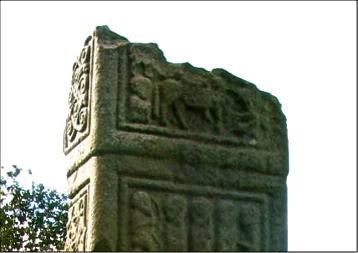
The Image
The image to the left is part of the Broken Cross at Kells (County Meath). About the broken panel at the top Helen Roe writes, "Enough remains of this badly mutilated panel for the subject to be identified as the Entry into Jerusalem, the opening scene of the Passion series.
"Christ rides from left to right; before Him a man 'spreads his garment in the way', and behind Him a man kneels, It is probable that other figures were originally included." (Roe, 1988, p 51)
This image appears on only three of the High Crosses: The Broken Cross as Kells [left], Arboe (west face); and Clonmacnois, Cross of the Scriptures, (west face of base). It may also appear on two others: Old Kilcullen (west face) and Donaghmore, County Tyrone (east face). The later two are uncertain identifications. (Harbison 1992, p. 261)
An Interpretation
As the writer of the Gospel of Mark tells the story, Jesus enters Jerusalem on the Sunday before the Passover. On that same day, the day following the Jewish Sabbath, it is probable that Pontius Pilate, Roman governor of Idumea, Judea, and Samaria also entered the city. It was typical for Roman governors to be in Jerusalem for the Passover, to personally handle any problems that might arise.
"Imagine the imperial procession's arrival in the city. A visual panoply of imperial power: cavalry on horses, foot soldiers, leather armor, helmets, weapons, banners, golden eagles mounted on poles, sun glinting on metal and gold. . . . Pilate's procession displayed not only imperial power, but also Roman imperial theology. According to this theology, the emperor was not simply the ruler of Rome, but the Son of God. . . . Inscriptions refer to him as 'son of God,' 'lord' and 'savior,' one who had brought 'peace on earth.' After his death, he was seen ascending into heaven to take his permanent place among the gods." (Borg and Crossan, p. 3)
"As Mark tells the story in 11:1-11, it [Jesus' entry into Jerusalem] is a prearranged ‘ counter-procession.' Jesus planned it in advance." (Borg and Crossan pp. 3-4) The procession follows the pattern of Zechariah 9.
Rejoice greatly, O daughter Zion! Shout aloud, O daughter Jerusalem! Lo, your king comes to you; triumphant and victorious is he, humble and riding on a donkey, on a colt, the foal of a donkey. He will cut off the chariot from Ephraim and the warhorse from Jerusalem; and the battle-bow shall be cut off, and he shall command peace to the nations; his dominion shall be from sea to sea, and from the River to the ends of the earth. (Zechariah 9:9-10)
"This king, riding on a donkey, will banish war from the land -- no more chariots, war-horses, or bows. Commanding peace to the nations, he will be a king of peace." (Borg and Crossan p. 4) This interpretation of the Entry into Jerusalem highlights the contrast between the Kingdom of God and the kingdoms of this world (specifically the kingdom ruled by Caesar). It suggests that Jesus was aware of the political and spiritual significance of his actions.
Maundy Thursday: Judas Betrays Jesus
The Text: Mark 14:43-46
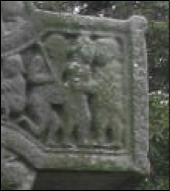
Immediately, while he was still speaking, Judas, one of the twelve, arrived; and with him there was a crowd with swords and clubs, from the chief priests, the scribes, and the elders. Now the betrayer had given them a sign, saying, ‘The one I will kiss is the man; arrest him and lead him away under guard.’ So when he came, he went up to him at once and said, ‘Rabbi!’ and kissed him. Then they laid hands on him and arrested him.
The Image
The image to the right is from the west face, the south arm of the Tall Cross at Monasterboice (County Louth). "On the right-hand arm, Judas and Christ, each clad in a garment to below the knee, embrace one another as a soldier, armed with sword and shield, approaches from the left, about to apprehend Christ.” (Harbison 1992, p. 151)
This image appears on only two High Crosses, the Tall Cross at Monasterboice (County Louth) to the right, and the Cross of the Scriptures at Clonmacnois (County Offaly). Other crosses that may contain this image include: the large cross-head at Ardane (County Tipperary), the South Cross at Castledermot (County Kildare), and the Market Cross at Kells (County Meath). (Harbison 1992, p. 263)
An Interpretation
The writer of Mark does not offer any explanation of Judas' motives for betraying Jesus. For Mark the important point to make is that it is one of the Twelve Disciples who betrays Jesus. In oppressive regimes trust is undermined. Fear of informants becomes a part of everyday life. Friends and family members may be guilty of betrayal. (Perkins, p. 700) Members of the church at the time of the writing of Mark's Gospel were experiencing persecution and experiencing the betrayal of family and friends.
Maundy Thursday: The ear of a slave cut off
The Text: Mark 14:47-50

But one of those who stood near drew his sword and struck the slave of the high priest, cutting off his ear. Then Jesus said to them, ‘Have you come out with swords and clubs to arrest me as though I were a bandit? Day after day I was with you in the temple teaching, and you did not arrest me. But let the scriptures be fulfilled.’ All of them deserted him and fled.
The Image
This scene appears for certain on only one of the High Crosses, the Tall Cross at Monasterboice (County Louth). On the upper panel of the head, on the west face is an image that has been interpreted as a follower of Jesus using a sword to cut off the ear of a slave. “Peter stands in the centre, holding a sword over his shoulder with his right hand, while his left holds the sword-sheath point downwards. He is flanked on each side by a figure holding up a torch on lantern.” (Harbison 1992, p. 151) It is possible that this image also occurs on the Market Cross at Kells (County Meath). (Harbison 1992, p. 264)
An Interpretation
The story of a bystander (presumably a disciple) cutting off the ear of the High Priest's slave raises more questions than it answers. Why was a disciple armed? Was this common practice? Could it have been a long knife such as the peasantry carried under their tunics rather than a sword? (Grant, 886) Is this another example in Mark of the failed discipleship of the Disciples? (Borg and Crossan, 124) As little attention as most commentators give to this particular episode the surprising thing is that this one sentence merited a panel on at least one of the High Crosses.
Peter Harbison's description of the image [above] follows the Gospel of John. John is the only of the four Gospels that names Simon Peter as the one who wielded the sword. Among Celtic Christians the Gospel of John was a favorite.
Maundy Thursday: The First Mocking or Flagellation
The Text: Mark 14:61b-65
The first trial of Jesus was before an unidentified group of Jewish religious leaders.. Following the testimony of a number of false witnesses Jesus seems to declare himself messiah.
’Again the high priest asked him, ‘Are you the Messiah, the Son of the Blessed One?’ Jesus said, ‘I am; and
“you will see the Son of Man seated at the right hand of the Power”, and “coming with the clouds of heaven.” Then the high priest tore his clothes and said, ‘Why do we still need witnesses? You have heard his blasphemy! What is your decision?’ All of them condemned him as deserving death. Some began to spit on him, to blindfold him, and to strike him, saying to him, ‘Prophesy!’ The guards also took him over and beat him.
The Image
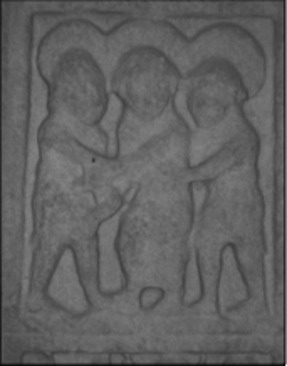
The Cross of the Scriptures at Clonmacnois offers one example of this image. Peter Harbison describes the panel in this way: “A central figure, shown frontally though with feet pointing to the left, is flanked on each side by a figure in profile, presumably a soldier. That on the left holds in his right hand a rod with which he strikes the central figure, presumably Christ, whose hands seem to be folded and possibly bound in front of him. In his left hand, the soldier on the left holds something which may be the rod of the soldier on the right whose hands are occupied in clutching Christ around the waist. The soldiers are presumably in the act of striking Christ in the first mocking scene or flagellation. Although all three figures appear to be haloed, it seems likely that the ‘haloes’ of the flanking soldiers are best explained as the crests of helmets.” (Harbison, 1992, 51)
This image also occurs on: the Durrow Cross (County Offaly) and Muiredach's Cross and the Tall Cross at Monasterboice (County Louth), It may also appear on: the large cross head at Ardane (County Tipperary) and a fragment of a cross from Drumcliff (County Sligo) held in the National Museum in Dublin. (Harbison 1992, p. 265)
An Interpretation
The first mocking of Jesus concludes a hearing before a group of Jewish authorities. Borg and Crossan point out that this group, however it is identified, consisted of Jewish leaders who regularly collaborated with the Roman authorities to maintain the peace and their own positions of authority. They identify three stages to this "trial." In the first stage witnesses testify. They do not agree and their testimony is characterized as "false." In the second stage the high priest seeks to elicit a confession. "Are you the Messiah, the Son of the Blessed One?" (Mark 14:61) According to Mark, Jesus responds by saying ego eimi. This can be translated in two ways. "I am" or "Am I?" This response is taken by the high priest as a confession and leads to Jesus' condemnation. The third stage of the "trial" begins the physical suffering of Jesus, his mocking or flagellation. (Borg and Crossan, 128-134)
Maundy Thursday: Peter's Denial of Jesus
Mark 14:66-72
While Peter was below in the courtyard, one of the servant-girls of the high priest came by. When she saw Peter warming himself, she stared at him and said, ‘You also were with Jesus, the man from Nazareth.’ But he denied it, saying, ‘I do not know or understand what you are talking about.’ And he went out into the forecourt. Then the cock crowed. And the servant-girl, on seeing him, began again to say to the bystanders, ‘This man is one of them.’ But again he denied it. Then after a little while the bystanders again said to Peter, ‘Certainly you are one of them; for you are a Galilean.’ But he began to curse, and he swore an oath, ‘I do not know this man you are talking about.’ At that moment the cock crowed for the second time. Then Peter remembered that Jesus had said to him, ‘Before the cock crows twice, you will deny me three times.’ And he broke down and wept.
The Image
One of the three or four examples of this image appears on the Tall Cross at Monasterboice (County Louth) below.
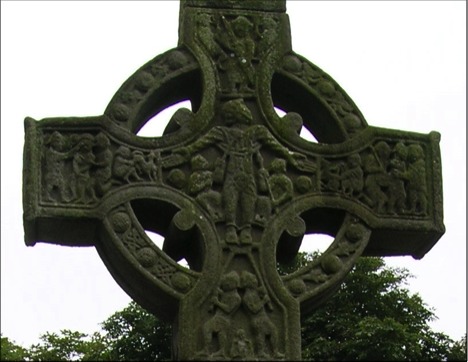
“The scene of THE DENIAL OF PETER on this cross is shown in two sections on the contractions of the arms, and separated by the CRUCIFIXION scene. In the contraction of the south (right-hand) arm we find Peter bending low and stretching out his hands over the round brazier to warm himself, while the cock crows above his hand. In the contraction of the north (left-hand) arm, we see the equally bent figure of the servant girl stretching out a querying hand towards Peter on the opposite arm and in front of her there is another cock. Above its tail there is a small semi-circle, perhaps representing an archway.” (Harbison, 1992, 150-1)
If you have difficulty seeing what Harbison describes, you are not alone. Helen Roe offers a very different interpretation. “Separated from the main subject on either side by a vertical bar are two small carvings: one a man milking a sheep, the other a man shearing a sheep or perhaps throwing it for slaughter. Both illustrate prophetic references to the Atonement (Isaiah 57.7)” (Roe, 52)
Either interpretation makes sense in the context of the other scenes on the head of the cross. On the right arm we have the betrayal of Jesus by Judas. On the left arm we have the mocking of Jesus. In the center is the crucifixion. If Harbison’s interpretation is accepted we have yet another scene related to the arrest and crucifixion. If Roe’s interpretation is accepted, we have a metaphorical statement about the meaning of the crucifixion.
Other images of Peter's Denial can be found on: the Market Cross at Kells (County Meath), also in the constriction of the arms; on the Durrow Cross (County Offaly); and perhaps on Muiredach's Cross at Monasterboice (County Louth). (Harbison 1992, p. 267).
An Interpretation
This particular section of Mark emphasizes Peter's denial of Jesus. He says that he does not know him. This denial follows two other scenes. First, Peter follows Jesus to the house of the High Priest. Next we have Jesus' own confession (as undertsood by the High Priest) that he is the Son of God. This leads to his condemnation and first mocking and flaggelation (see above). Jesus' courageous response to the High Priest is followed immediately by Peter denying Jesus before bystanders.
Borg and Crossan point out that Mark was written to a Christian community that had suffered "lethal persecution in the Jewish homeland during the great rebellion of 66-74 CE." They suggest there were three message intended for the church in the telling of these events. "First, those who imitated Jesus rather than Peter are applauded for their courage. Second, even those who imitated Peter rather than Jesus are consoled with the hope of repentance and forgiveness. . . Third, neither denials nor even betrayals are the worst sin against Jesus or God. The worst sin is despair -- loss of faith that repentance will always, always obtain forgiveness." (Borg and Crossan p. 135)
Good Friday: Pilate Washes His Hands
The Text: Matthew 27:24
So when Pilate saw that he could do nothing, but rather that a riot was beginning, he took some water and washed his hands before the crowd, saying, ‘I am innocent of this man’s blood; see to it yourselves.’ (Matthew 27:24)
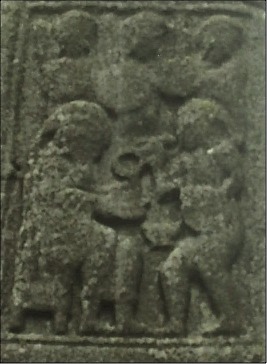
The Image
Helen Roe describes the image on Muiredach's Cross at Monasterboice (left) as follows: "On the left Pilate, heavily bearded and clad in a long robe sits in a high-backed chair. Before him a slave pours water from a long-handled scoop-like vessel over his outstretched hands. Above (i.e. in the background), three of the Praetorian guard armed with swords and shields stand in a row." (Roe, pp. 37-38)
The image of Pilate washing his hands (of responsibility for the death of Jesus) appears on only two High Crosses: Muiredach's Cross at Monasterboice (County Louth) and the Durrow Cross (County Offaly). There is a possible third occurence on the Tall Cross, also at Monasterboice.
An Interpretation
It is unlikely that this event actually took place. It almost certainly has its origin with the writer of Matthew. He was looking back to the Jewish War of 66-74 CE mentioned above (Peter's Denial of Jesus). Tension between Jews and Christians was high. Jewish Christians in Judea and elsewhere were being excluded from the Synagogue. This meant thier worship was not sanctioned by Rome and was thus illegal. But the end result of the Jewish War was the defeat of the Jews and the destruction of Jerusalem and the Temple in the year 70. Christians of the time saw this as punishment for the Jewish condemnation of Jesus.
It is important to note that this passage has been taken across the centuries as a sign of the guilt of all Jewish people of all time. It is said they condemn themselves by denying and condemning Jesus. But instead, we must read this text in the context of the times outlined above. The Christian movement was in the process of breaking with Judiasm and was seeking a legal status within the empire that would end persecution from that corner.
Eugene Boring writes about the spiritual dynamics of the situation as follows: ".. . one should see this scene as the confrontation of two kingdoms . . . the options of royal power exerted through violence and the authority and power of God present in meekness . . . " (Boring p. 487) Matthew tells us that the people, or their leaders, choose violence over the God's kingdom.
Sherman Johnson addresses the general human condition when he writes, ". . . Jesus' condemnation is in fact a dramatic manifestation of the general sin of mankind. Human beings continually acquiesce in slaying the innocent in order to protect their own privileges, or to maintain what they think is the right social order, or because the forthrightness of prophets offends their self-righteousness." (Johnson, p. 599)
Pilate washing his hands of the affair is inconceivable. To have shirked his responsibility as representative of the Empire would have been a sign of weakness. Even if he felt cornered by the Jewish authorities, he would not want them to believe they had bested him. (Johnson, p. 598)
Good Friday: The Second Mocking of Jesus
The Text: Matthew 27:27-31
Then the soldiers of the governor took Jesus into the governor’s headquarters, and they gathered the whole cohort around him. They stripped him and put a scarlet robe on him, and after twisting some thorns into a crown, they put it on his head. They put a reed in his right hand and knelt before him and mocked him, saying, ‘Hail, King of the Jews!’ They spat on him, and took the reed and struck him on the head. After mocking him, they stripped him of the robe and put his own clothes on him. Then they led him away to crucify him.
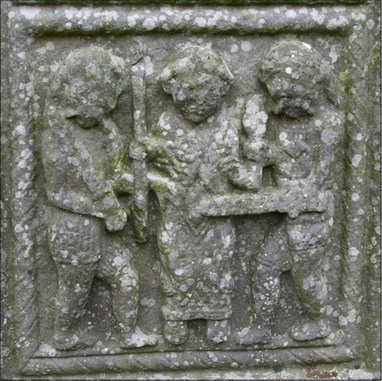
The Image
At first glance the images of the Second Mocking appear to be essentially the same as those of the First Mocking and the Arrest of Jesus. Peter Harbison's description of the scene as it appears on Muiredach's Cross at Monasterboice (right) points to the differences.
"Christ stands in the centre wearing a long garment with pelleted hem at the ankles, over which he wears a cloak with folds at the shoulder and with spiral ornament in relief on the sides. It is fastened by a brooch. From beneath the cloak Christ's right hand emerges, holding up a vertical staff or reed. His raised left forearm is held by a soldier on the right who is clad, seemingly in short 'gadrooned' breeches rather than a tunic, and bearing a panel bands on the chest, often considered to be attached by a brooch with lozenge -- or kite-shaped head. In his left hand this mustached soldier holds a sword, with the point at Christ's navel. A similarly-clad soldier on the left holds a grooved sword over his right shoulder as his left hand pulls at the side of Christ's cloak. Often taken to be THE ARREST OF CHRIST -- which never shows Christ holding a reed -- this panel is better interpreted as Christ, carrying the reed which he had been given, and being mocked by the soldiers who are about to divest him of the purple or scarlet robe which they had placed upon him, as they hail him as 'King of the Jews'." (Harbison 1992, pp. 143-144)
This image appears on the cross at Arboe (County Tyrone), the South Cross at Castledermot (County Kildare), the Donaghmore Cross (County Tyrone), the Drumcliff Cross (County Sligo), and Muiredach's Cross at Monasterboice (County Louth). It may also appear on the Market Cross at Kells (County Meath) and Larger Cross-head at Ardane (County Tipperary).
An Interpretation
The society of which Jesus was a part can be described sociologically as an "Honor-Shame Society." The entry of Jesus into Jerusalem on Palm Sunday to the acclamation of the people testifies to the high honor status Jesus had achieved. His status far exceeded what would have been expected for a village carpenter.
In order to deal with Jesus' popularity, the authorities had to destroy his honor status. This process can be described as a "Status Degradation Ritual." In the scenes above, beginning with Jesus betrayal and arrest, he is subjected to one degradation after another.
Bruce Malina and Richard Rohrbaugh describe this sociological perspective on the events of Thursday and Friday of Holy week in their book Social-Science Commentary on the Synoptic Gospels. Here is how they describe the process: "The status degradation ritual is a process of publicly recasting, relabeling, humiliating, and thus re-categorizing a person as a social deviant. Such rituals express the moral indignation of the denouncers and often mock or denounce a person's former identity in such a way as to destroy it totally. Usually it is accompanied by a revisionist account of the person's past which indicates that he has been a deviant all along. A variety of social settings -- trials, hearings, political rallies -- can be the occasion for this destruction of a person's public identity and credibility." (Malina and Rohrbaugh, p. 159)
In the case of Jesus, this process begins with his arrest. It continues with his hearing before the Jewish authorities. His first mocking and flagellation complete the first phase of his degradation. This is followed by his trial before Pilate and the charges made against him. In an ironic twist of affairs, the crowd comes to demand the release, not of Jesus, but of a criminal named Barabbas. The irony is that the name Barabbas means "Son of the Father." According to the Gospels Jesus is in fact the Son of God (the Father).
The degradation of Jesus then continues with his second mocking and crucifixion. All of his supporters have fallen away and the crowd has turned against him. The final degradation is crucifixion itself. It was so shameful that in most cases even the family never mentioned the person again. The victim had lost all status and become a nobody.
Good Friday: Soldiers Cast Lots for Jesus Clothes
The Text: Mark 15:21-24
They compelled a passer-by, who was coming in from the country, to carry his cross; it was Simon of Cyrene, the father of Alexander and Rufus.Then they brought Jesus to the place called Golgotha (which means the place of a skull). And they offered him wine mixed with myrrh; but he did not take it. And they crucified him, and divided his clothes among them, casting lots to decide what each should take.
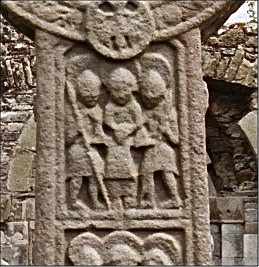
The Image
The image to the left is found on the Scripture Cross at Clonmacnois (County Offaly). Peter Harbison describes it as follows: "Of the three figures, presumably all representing soldiers, that in the centre is shown frontally, while the other two flanking figures are shown in half-profile. The two flanking soldiers hold up spears diagonally across their bodies. The soldier in the centre holds a knife in his right hand and with his left he holds one arm of the T-shaped garment which falls to the level of his knees, and the other arm of the garment is clasped by the left hand of the left-hand soldier. The central soldier is clothed in a robe to the ankles, presumably in order not to have the body of Christ's garment confused with his tunic, as the bottom of the garment is of approximately the same height as that of the tunics of the flanking soldiers. The scene is presumably intended to show the moment when the soldier hesitates about cutting up the seamless garment. As with the panel beneath, the 'haloes' of the soldiers are best understood as the crests of helmets." (Harbison 1992, p. 51)
According to Harbison, this image appears only on the Cross of the Scriptures at Clonmacnois (County Offaly), the Durrow Cross (County Offaly) and possibly on the Tall Cross at Monasterboice (County Louth).
An Interpretation
The casting of lots for Jesus' clothing, or the division of his garments among the soldiers, is probably a historical fact. The clothing was the spolia, and belonged to the executioners of the prisoner. It is possible that this was actually done before the journey to the cross. The prisoner was typically led naked to the site of crucifixion. (Grant, p. 903) The inclusion of this brief statement in Mark's Gospel serves a deeper purpose than the recitation of history. It is one of several references in the story of the crucifixion to Psalm 22. "As part of the Jewish Bible, Psalm 22 is a prayer for deliverance. The prayer describes a person experiencing immense suffering with intense hostility. . . Though he has trusted in God from birth, now in his extremity he is scorned, despised, and mocked. He feels abandoned by everybody, friends and God. (Borg and Crossan, p. 158) In Psalm 22:18 we read: "They divide my clothes among themselves, and for my clothing they cast lots."
References cited:
Borg, Marcus J. and Crossan, John Dominic, The Last Week: What the Gospels Really Teach About Jesus's Final Days in Jerusalem, HarperSanFrancisco, 2006.
Boring, Eugene M., The New Interpreter's Bible, vol. VIII, Matthew, Abingdon Press, Nashville, 1995.
Grant, Frederick C., The Interpreter's Bible, vol. VII, Mark, Abingdon Press, Nashville, 1951.
Harbison, Peter; "The High Crosses of Ireland: An Iconographical and Photographic Survey", Dr. Rudolf Habelt GMBH, Bonn, 1992. Volume 1: Text, Volume 2: Photographic Survey; Volume 3: Illustrations of Comparative Iconography.
Johnson, Sherman E., The Interpreter's Bible, vol. VII, Matthew, Abingdon Press, Nashville, 1951.
Malina, Bruce J. and Rohrbaugh, Richard L., Social Science Commentary on the Synoptic Gospels, Fortress Press, Minneapolis, 1992.
Perkins, Pheme, The New Interpreter's Bible, vol. VIII, Mark, Abingdon Press, Nashville, 1995.
Roe, Helen M, The High Crosses of Kells, Meath Archaeological and Historical Society, 1988.